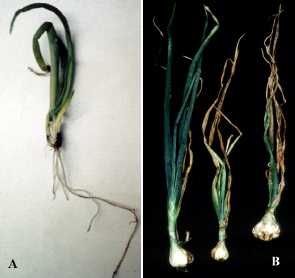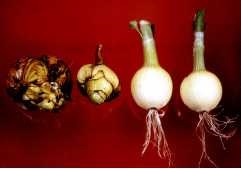Bulb and stem nematode in onions and carrots
Learn symptoms, biology and control practices of bulb and stem nematode on onions and carrots.
Introduction
The bulb and stem nematode (Ditylenchus dipsaci) occurs in many regions around the world and is a particularly destructive pest on vegetables grown in temperate climates.
Although many different crops are susceptible to invasion by this nematode, more than 20 biological races have been identified. Only a few of these races are know to occur in Canada and the federal government regulates the importation of potential hosts of exotic races to prevent their entry. Some biological races are host or crop specific while others are capable of invading more than one host. Crops infected by bulb and stem nematode include onions, garlic, leeks, chives, shallots, peas, beets, carrots, celery, tomato, cucumber, narcissus, hyacinth, tulip, oats, rye, alfalfa, red clover, phlox and strawberry. Onions are susceptible to several of these races of bulb and stem nematode.
Due to the potentially high economic importance and fast reproductive rate of these nematodes, it is imperative that control measures are put into place to:
- prevent the introduction of this nematode pest into growers fields and
- in fields where it is present, to keep population levels below economic thresholds.
Since the first reported outbreak in Ontario during 1957, the bulb and stem nematode has not caused severe problems for most Ontario vegetable growers. This is due to good crop rotations with non-host crops for 3 or more years, which virtually eliminates the nematode from infested soils. Recent surveys have detected the presence of the bulb and stem nematode at very low population levels in muck soil at a few sites on the Holland Marsh.
Although the incidence and soil populations were low, the nematodes were detected in both carrot and onion fields. No bulb and stem nematode symptoms on either carrot or onion were observed in the fields sampled, but damage from this plant parasitic nematode can devastate yield and quality.
Symptoms
Onions
Symptoms of bulb and stem nematode infestations on different crops vary depending on crop and population of nematodes.
In onions, the base of infected seedlings appears swollen and leaves appear twisted, malformed and may bear slightly raised pimple like spots (Figure 1).

Severely infected plants eventually turn yellow and die. Scales on older infected bulbs often split and appear swollen or bloated (Figure 2).
Symptoms frequently look similar to damage caused by onion maggot. Infected bulbs are also very susceptible to secondary infections by bacteria and fungi.

Carrots
Although strains of the bulb and stem nematode that infect carrots have not been confirmed in Ontario, growers should become familiar with the damage symptoms.
Young carrot seedlings develop distorted leaves and by harvest time, infected crowns become spongy and crumbly making mechanical harvesting difficult. The symptoms often resemble those caused by Aster Yellows. Infected carrots are also more prone to infection from crown rot fungi and soft rot bacteria.
Biology
Bulb and stem nematode activity begins early in the spring when they leave the soil under conditions of high humidity caused by a recent rain or heavy dew. The nematodes travel in the film of water covering the surface of stem and leaves. In onions the nematodes will move down inside the leaf sheath until they reach the bulb and feed between onion scales. During feeding, the nematode injects saliva-containing a toxin (enzyme) into the cells, which creates the lesions and stimulates distorted growth.
They prefer moist muck soil and are less likely to cause damage during hot, dry seasons. However, irrigation can encourage the invasion of susceptible crops during drought periods. The nematodes can spread through irrigation water, infected bulbs or seed, and on contaminated equipment. They can survive freezing or extreme dry conditions in a dormant state in dried infested plant residues.
Recommendations for control
Vegetable growers should consider having a nematode test done on fields in the fall after harvest or in the spring before cultivation to determine if the bulb and stem nematode is present.
Clean seed, sets, bulb
Make every effort to insure that seed, sets from onions, garlic, shallots and flower bulbs are clean to prevent contaminating your farm. Sets and bulbs should be examined carefully and only plant if they appear perfectly healthy. Infected sets tend to be soft, shrunken and discolored (dark brown) near the neck of the plant and are lighter in weight.
Sanitation
Dispose of cull onions and carrots away from the field, where they will not contaminate irrigation canals. Clean off soil adhering to equipment before moving between fields. Remove infested plants and debris from both field and storage, then destroy them.
Rotation
Rotate all fields, including those with low populations, with a non-host crop for 3 years.
Fumigation
Field fumigation with a registered fumigant in the fall prior to planting a susceptible crop the following spring has also been shown to effectively control these nematodes.